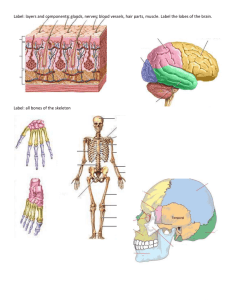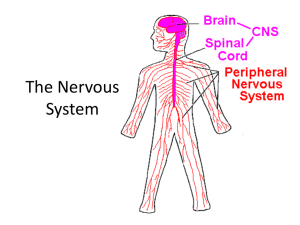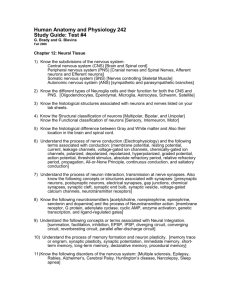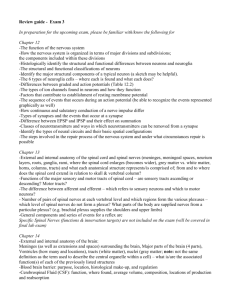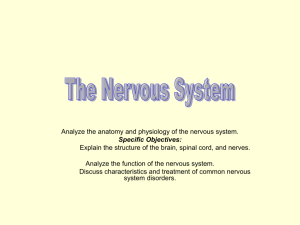Anatomy3_Midterm_Study_Guide
advertisement
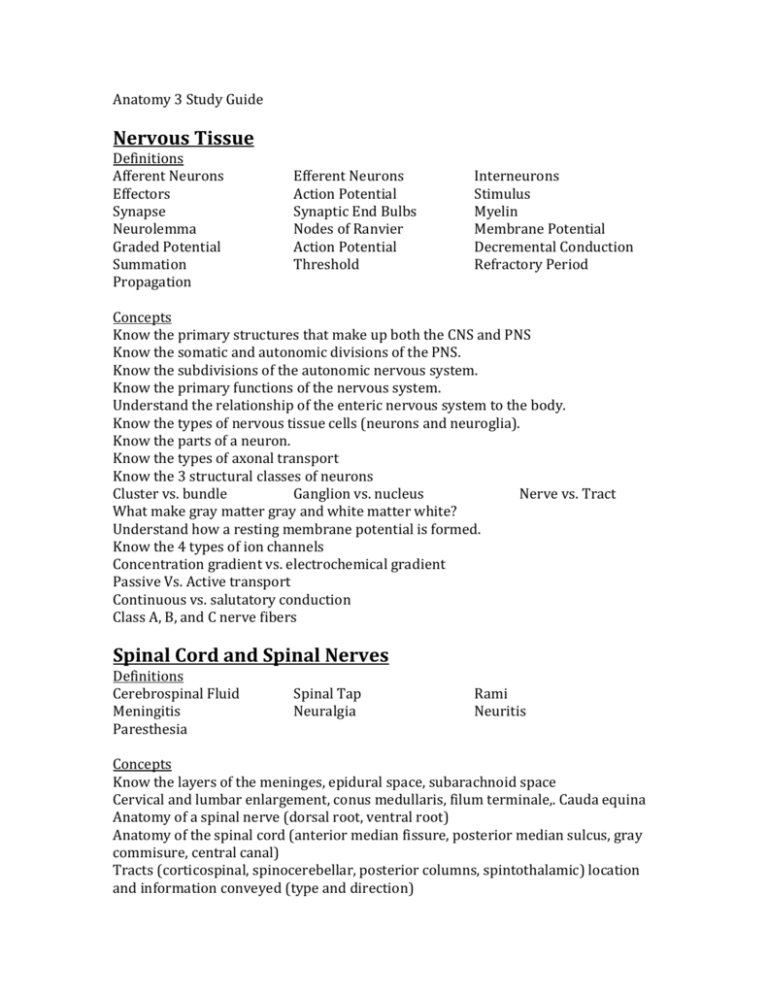
Anatomy 3 Study Guide Nervous Tissue Definitions Afferent Neurons Effectors Synapse Neurolemma Graded Potential Summation Propagation Efferent Neurons Action Potential Synaptic End Bulbs Nodes of Ranvier Action Potential Threshold Interneurons Stimulus Myelin Membrane Potential Decremental Conduction Refractory Period Concepts Know the primary structures that make up both the CNS and PNS Know the somatic and autonomic divisions of the PNS. Know the subdivisions of the autonomic nervous system. Know the primary functions of the nervous system. Understand the relationship of the enteric nervous system to the body. Know the types of nervous tissue cells (neurons and neuroglia). Know the parts of a neuron. Know the types of axonal transport Know the 3 structural classes of neurons Cluster vs. bundle Ganglion vs. nucleus Nerve vs. Tract What make gray matter gray and white matter white? Understand how a resting membrane potential is formed. Know the 4 types of ion channels Concentration gradient vs. electrochemical gradient Passive Vs. Active transport Continuous vs. salutatory conduction Class A, B, and C nerve fibers Spinal Cord and Spinal Nerves Definitions Cerebrospinal Fluid Meningitis Paresthesia Spinal Tap Neuralgia Rami Neuritis Concepts Know the layers of the meninges, epidural space, subarachnoid space Cervical and lumbar enlargement, conus medullaris, filum terminale,. Cauda equina Anatomy of a spinal nerve (dorsal root, ventral root) Anatomy of the spinal cord (anterior median fissure, posterior median sulcus, gray commisure, central canal) Tracts (corticospinal, spinocerebellar, posterior columns, spintothalamic) location and information conveyed (type and direction) Know the types of reflex arcs Know the 5 functional components of a reflex arc Know the somatic spinal reflexes discussed in class (stretch, tendon, flexor, extensor) Know the plantar flexion reflex and Babinski sign Connective tissue coverings of spinal nerves (endoneurium, perineurium, epineurium) Know the major plexuses and the regions they supply (cervical, brachial, lumbar, sacral, coccygeal) Know the following major nerves and the regions they supply (radial, median, ulnar, femoral, sciatic) Know the dermatomes for the upper and lower extremities Brain and Cranial Nerves Definitions Decussate Word deafness Anopia Diplopia Aphasia word blindness strabismus Trigeminal neuralgia nonfluent aphasia anosmia ptosis Bell’s palsy Concepts 4 major parts of the brain Know the primary functions of each division 3 subdivisions of the brain stem 3 subdivisions of the diencephalon Corpus collosum Pineal gland Internal carotid arteries, vertbrobasilar arteries, internal jugular veins Blood brain barrier (function, what can pass, what cell forms) Falx cerebri, falx cerebelli, tentorium cerebelli 4 ventricles, interventricular foramen, cerebral aqueduct, choroid plexus, ependymal cells) 4 primary lobes of the brain (frontal, parietal, temporal, occipital) Concussion, contusion, laceration Precentral gyrus (primary motor area), post central gyrus (primary somatosensory area), central sulcus, visual association area, auditory association area, gustatory area, wernicke’s area, broca’s area 12 cranial nerves and their primary function Sensory, Motor, and Integrative Systems Definitions Sensory modality Selectivity Nociceptor Osmoreceptor Sensory receptor mechanoreceptors photoreceptor somatic sensations stimulus thermoreceptor chemoreceptor cutaneous sensations Meissner corpuscles Ruffini corpuscles Referred pain hair root plexuses pacinian corpuscles analgesia merkel discs phantom limb sensation proprioception Concepts Sensation vs. perception (conscious vs. subconscious sensation) General senses (somatic and visceral) vs. special senses 3 sensory receptor types 4 events in sensation Microscopic structural characteristics (provide examples of each type) Generator potential vs. receptor potential Exteroreceptor vs. interoreceptor Types of stimuli detected / 4 modes of somatic sensation muscle spindles, tendon organs, joint kinesthetic receptors First-order, second-order and third-order neurons Relay Stations Lower motor neurons / upper motor neurons






